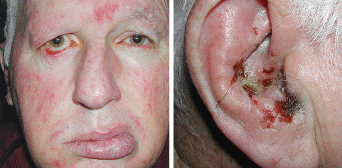History A 68-year-old white male presented with a chief complaint of right facial droop and ocular pain that had persisted for five days. He demonstrated no other associated systemic signs and denied experiencing trauma of any kind. He had no previous ocular history. Diagnostic Data His best-uncorrected visual acuity measured 20/50 O.D. and 20/20 O.S. Extraocular muscles, fields and pupils were normal, with no afferent pupillary defect O.U. Your Diagnosis How would you approach this case? Does this patient require any additional tests? What is your diagnosis? How would you manage this patient? Whats the likely prognosis? Discussion Additional testing should include an evaluation of the seventh cranial nerve. Instruct the patient to close his or her eyes, smile, wrinkle the forehead and forcefully close the eyes against resistance. This will help you localize the problem to either the upper motor neuron (central vision) or lower motor neuron (peripheral vision) as well as help you establish the presence of a strong protective Bells reflex. In some cases, the patient may require neuroimaging, laboratory studies or referral to a neuro-ophthalmologist. Additionally, examine and stain the cornea to detect sensitivity loss and/or the existence of a keratopathy. Common treatments for Ramsay Hunt syndrome include protection of the cornea with lubrication, occlusion, taping and/or tarsorrhaphy. Also, pharmacologic treatment of the herpes infection with antiviral and steroid therapy is warranted. Surgical solutions for residual deficits, such as ectropion, may be necessary. In our patients case, we started treatment with 500mg famciclovir p.o. t.i.d. O.D., bacitracin ophthalmic ointment b.i.d. O.D. and preservative-free Bion Tears (Alcon) qh to q2h O.D. as well as eyelid taping to reduce corneal exposure. During his recovery, our patient experienced prolonged bouts of exposure keratopathy, which forced us to complete a reversible lateral tarsorrhaphy O.D. 
His systemic history was positive for hypertension, pulmonary edema and rosacea. His current medications included Coumadin (warfarin, Bristol-Myers Squibb), nifedipine and doxycycline. He reported no history of allergy.
Biomicroscopy revealed superficial keratopathy O.D. Intraocular pressure measured 16mm Hg O.U. Dilated fundus evaluation was within normal limits O.U.

This 68-year-old male presented with a chief complaint of facial droop and ocular pain that had persisted for five days. What is your diagnosis?
The diagnosis in this case is herpes zoster oticus, or Ramsay Hunt syndrome. Ramsay Hunt syndrome involves a combination of facial nerve palsies and accompanying vesicles that are located on the pinna of the ear and in the auditory canal. Patients with Ramsay Hunt syndrome may also experience severe pain, hearing loss, dizziness, tinnitus, nausea and vertigo.1-19
Ramsay Hunt syndrome results when the dormant varicella zoster virus becomes reactivated in the facial nerve and cranial nerves VII and VIII.5-7 Though the disease is significantly less common than Bells palsy, Ramsay Hunt syndrome has the potential to produce more severe symptoms, which often result in a poor prognosis.5,8-10 Only 35% of patients recover completely, while 40% of patients experience some permanent loss of function and discomfort.5,8-10
Ramsay Hunt syndrome is the third leading cause of cranial nerve VII palsy, behind Bells palsy and trauma.1,19 People who are age 60 and older or immunocompromised are more susceptible to Ramsay Hunt syndrome than younger, healthy people.2,5,10,19 Also, post-herpetic pain and neuralgia often persist for longer periods in older patients.2,5,10,19 Fewer than 10% of patients affected by Ramsay Hunt syndrome historically recall a previous herpes zoster infection.19
Six weeks after the initial presentation, the patients visual acuity improved to 20/20 O.D. However, the significant ectropion did not improve. So, we sent the patient to an oculoplastics specialist to undergo a right lower lid ectropion repair.
Thanks to Caroline Beesley, O.D., of Birmingham, Ala., for contributing this case.
1. Sweeney CJ, Gilden DH. Ramsay Hunt syndrome. J Neurol Neurosurg Psychiatry 2001 Aug;71(2):149-54.
2. Rahimi AR. Ramsay Hunt syndrome: A challenging herpes zoster virus infection. Geriatrics 1998 Apr;53(4):93-4,101-2.
3.
4. Wayman DM, Pham HN, Byl FM, Adour KK. Audiological manifestations of Ramsay Hunt syndrome. J Laryngol Otol 1990 Feb;104(2):104-8.
5. Morrow MJ. Bells palsy and herpes zoster oticus. Curr Treat Options Neurol 2000 Sep;2(5):407-16.
6. Adour KK, Ruboyianes JM, Von Doersten PG, et al. Bells palsy treatment with acyclovir and prednisone compared with prednisone alone: a double-blind, randomized, controlled trial. Ann Otol Rhinol Laryngol 1996 May;105(5):371-8.
7. Schirm J, Mulkens PS. Bells palsy and herpes simplex virus. APMIS 1997 Nov;105(11):815-23.
8. Devriese PP, Moesker WH. The natural history of facial paralysis in herpes zoster. Clin Otolaryngol Allied Sci 1988 Aug;13(4):289-98.
9. Tomita H, Tanaka M, Kukimoto N, et al. An ELISA study on varicella zoster virus infection in acute facial palsy. Acta Otolaryngol Suppl 1988;446:10-6.
10.
11. Nogueira RG, Seeley WW. Ramsay Hunt syndrome associated with spinal trigeminal nucleus and tract involvement on MRI. Neurology 2003 Nov 11;61(9):1306-7.
12. Shapiro BE, Slattery M, Pessin MS. Absence of auricular lesions in Ramsay Hunt syndrome. Neurology 1994 Apr;44(4):773-4.
13. Gurwood AS. The Eyelid and Neuro-ocular Disease. In: Blaustein, BH (ed). Ocular Manifestations of Neurologic Disease.
14. Gurwood AS, Tasca JM, Kulback E. A Review of Cranial Nerve VII Palsy with Emphasis on Bells Palsy. S J Optom 1996 Mar;14(3):13-7.
15. May M, Galetta S. The Facial Nerve and Related Disorders of The Face. In: Glaser JS (ed). Neuro-ophthalmology, 2nd ed.
16. Cullom RD, Chang B. Neuro-ophthalmology: Isolated Seventh Nerve Palsy. In:
17. Bajandas FJ, Kline LB. Seven Syndrome of The Seventh (Facial) Nerve. In: Bajandas FJ, Kline LB. Neuro-ophthalmology Review Manual, 3rd ed.
18. Danielides V, Skevas A, van Cauwenberge P, et al. Facial nerve palsy during pregnancy. Acta Otorhinolaryngol Belg 1996;50(2):131-5.
19. Liesegang TJ. Varicella-zoster virus eye disease. Cornea 1999 May;18(5): 511-31.

